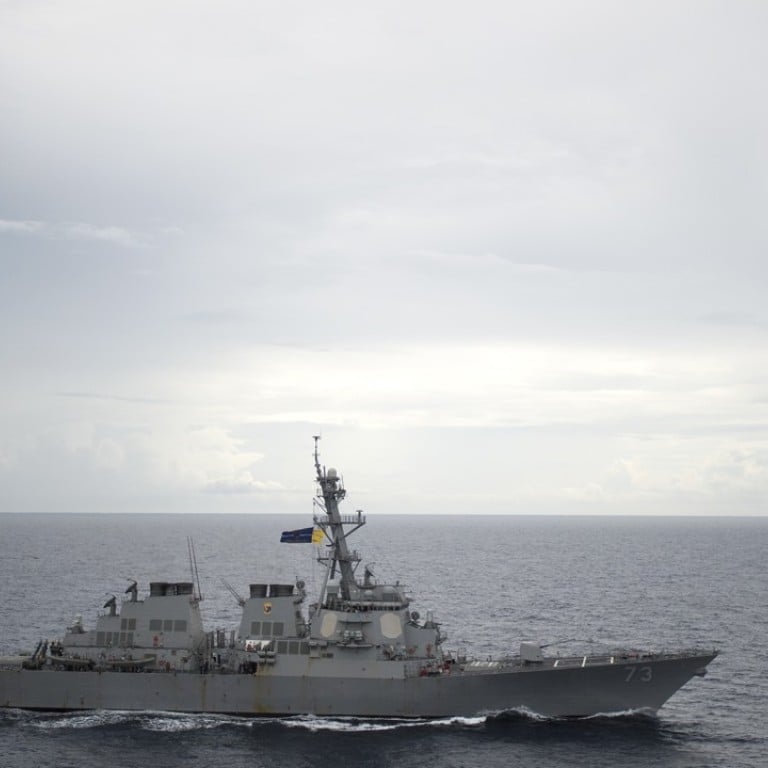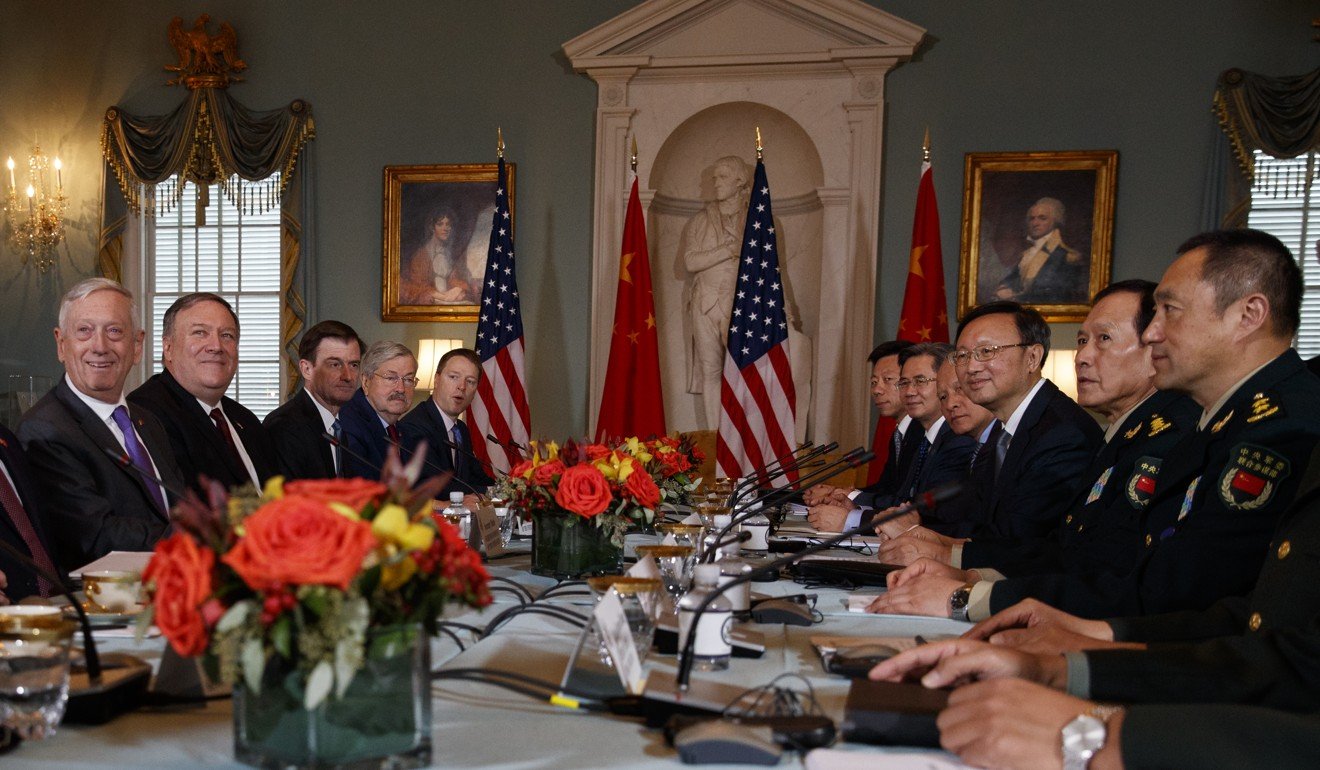
Top US officials reject Chinese demand to stop military moves that ‘undermine’ Beijing’s sovereignty in South China Sea
- US Secretary of State Mike Pompeo and US Defence Secretary James Mattis meet with Chinese counterparts in Washington
- Despite differing views, Chinese Defence Minister Wei Fenghe described talks as constructive ‘so that this military relationship will be a source of stability’
Top US officials rejected a warning by China on Friday to stop sending American vessels into the South China Sea, the latest focus of military tensions after warships from the two navies nearly collided in the disputed waters.
The warning and its dismissal came at a top-level “diplomatic security dialogue” in Washington, jointly chaired by US Secretary of State Mike Pompeo and Defence Secretary James Mattis, Chinese politburo member Yang Jiechi and Defence Minister Wei Fenghe.
In a news conference after the meeting, Yang warned his hosts that “the United States should stop sending its vessels and military aircraft close to Chinese islands and reefs and stop actions that undermine Chinese sovereignty and security interests”.

Mattis responded that “the United States will continue to fly, sail and operate wherever international law allows,” while Pompeo criticised China’s “militarisation” of the South China Sea.
Yang, China's highest-ranking diplomat and director of the Office of Foreign Affairs of the Central Commission of China's ruling Communist Party, dismissed that accusation by asserting Beijing’s sovereignty over the disputed area.
“On its own territory, China is undertaking construction to build civilian facilities and necessary defence facilities,” he said. “That is the right to preservation and self-defence that international law provides for and has nothing to do with militarisation.”
Despite the cautionary statements and the exchange of significantly differing points of view, both sides seemed to regard the talks as constructive.
Mattis and Wei re-emphasised the militaries’ role as a stabilising force in the countries’ relationship. Mattis characterised the talks as “a candid discussion” in which the countries “sought ways to lessen tension, maintain open lines of communication between our militaries and reduce the risk of miscalculation.”
Watch: The South China Sea dispute explained
Wei regarded the dialogue as “productive and positive”, saying that the two sides shared the view to “further step up strategic trust, properly handle differences, promote exchanges and cooperation so that this military relationship will be a source of stability for the overall bilateral ties”.
It marked the second consultation between Mattis and Wei in less than four weeks. The two met in Singapore on October 18 on the sidelines of a regional security forum, in an effort to maintain high-level contacts between the two militaries and reduce the risk of potential conflict after a Chinese and American warship nearly collided in the South China Sea in late September.
Mattis had been scheduled to meet Wei in Beijing in October, but the plans were cancelled after Washington in late September sanctioned a Chinese People’s Liberation Army equipment unit and its director, a lieutenant general, for buying weapons from Russia.

The day of talks in Washington came ahead of the meeting between US President Donald Trump and Chinese President Xi Jinping in the G20 summit in Buenos Aires, Argentina, at the end of the month.
The talks on Friday also provided another channel to discuss issues of critical interest to both nations, which are engaged in a highly fractious trade war. Ahead of the meeting, Daniel Russel, a former assistant secretary of state for East Asian and Pacific affairs during the Obama administration, said that “there is real urgency in stopping the downward spiral” of US-China relations.
“Both sides need to describe the kind of relationship they want between the two countries and begin a process of exploring how to get there,” Russel, now at the Washington-based Asia Society Policy Institute, said. “They must also explore ways to reconcile approaches to key issues like North Korea and Iran.”
Watch: A rare view of the South China Sea
“It is important they use the meeting to lay out their respective strategic goals and concerns, and not simply exchange recriminations and rhetoric,” he added.
The discussion was the second US-China Diplomatic and Security Dialogue, a negotiation framework initiated by Trump and Xi when they met at Trump’s Mar-a-Lago resort in Florida in April 2017.
The first meeting was in June 2017, also in Washington; then, North Korea’s nuclear threat was the priority because of Pyongyang’s increased programme of nuclear and inter-continental ballistic missile testing.
Tensions on the Korean peninsula have largely de-escalated since North Korean leader Kim Jong-un paused his provocative nuclear weapons programme and spent much of this year embracing diplomacy with China, South Korea and then the US.
Meanwhile, Beijing and Washington have engaged in a tit-for-tat trade war – imposing punitive tariffs on hundreds of billions of dollars worth of each other’s exports – since the summer.
And in the fall, tensions have spread to the South China Sea and Taiwan Strait, aggravating the two nations’ military relations. In the past two months, the US has flown B-52 bombers and conducted “freedom of navigation” operations in the vicinity of the South China Sea; US warships have sailed through the Taiwan Strait in support of Taiwan.
In Friday’s meeting, Pompeo reaffirmed Washington’s commitment to the US one-China policy, based on the US’s Taiwan Relations Act and the three joint communiques that define the rules of US engagement with the self-ruled island. He called on China to restore cross-Strait stability and respect Taiwan’s international space.
“The United States opposes unilateral actions by any party aimed at altering the status quo, including any resort to force or coercion,” Pompeo said.
The Chinese side repeated its position on Taiwan as “inseparable part from China”. During the joint press conference, Chinese defence chief cited US's oath of allegiance in which it said the US is “one nation under the God, indivisible”.
“So it is the same with Taiwan. It is an inalienable part of China,” Wei said. “So if this territorial integrity is under threat, we will do it at any cost just like what the US side had in Civil War,” he added.
Watch: Video shows near collision between US and Chinese warships
Then, in late September, an American destroyer, the Decatur, sailed near an islet claimed by Beijing in the Spratly archipelago, known in China as the Nansha Islands.
The Chinese ship came within 41 metres (135 feet) of the US vessel, leading the Pentagon to accuse the PLA Navy of conducting an aggressively “unsafe and unprofessional manoeuvre”.
Beijing claims sovereignty over the South China Sea and has long opposed US military aircraft flying over and warships sailing near the region.
China also strongly rejects any official US contact or arms sales to Taiwan, the self-ruled island that Beijing views as a renegade province, to be brought into line by force if necessary.
On October 25, during an inspection tour of Guangdong province, Xi told the military responsible for monitoring Taiwan and the South China Sea to “prepare for war”. On the same day, Wei vowed that China would not cede “a single inch” of its territory.

